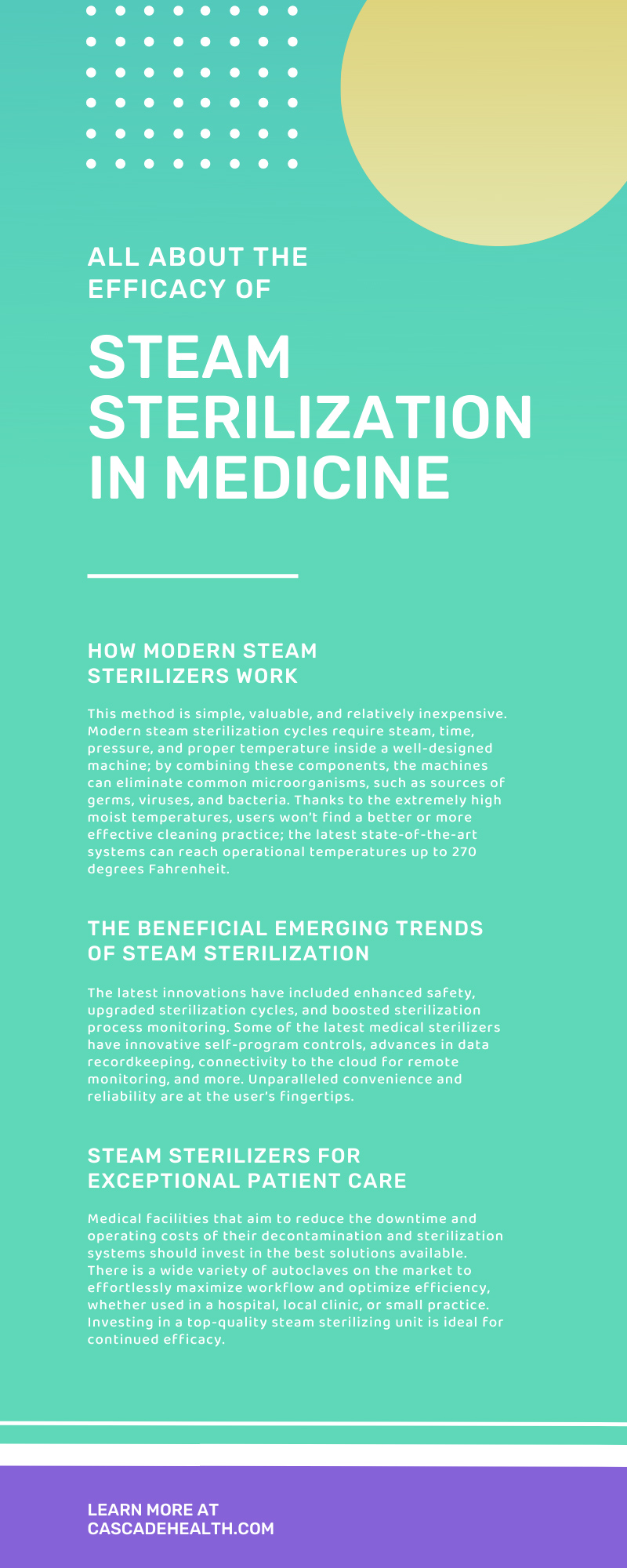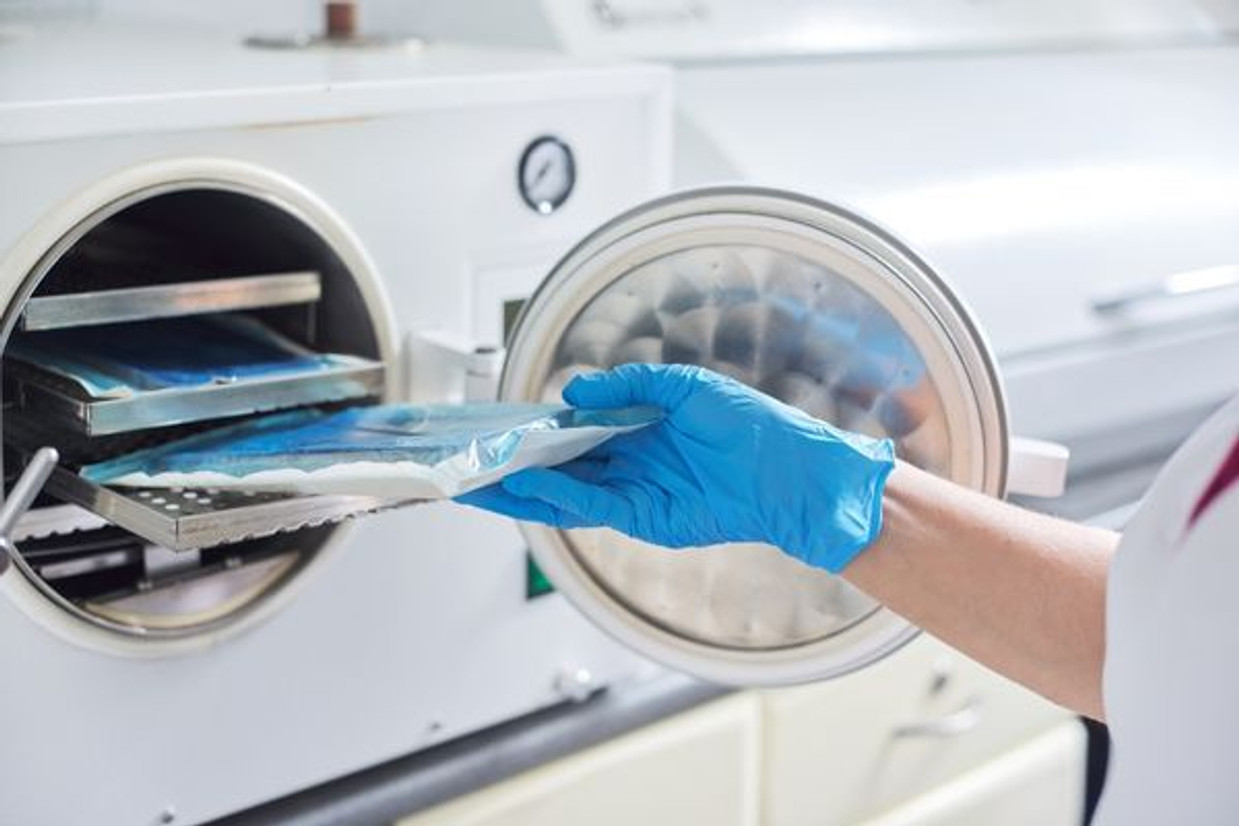All About the Efficacy of Steam Sterilization in Medicine
Today’s healthcare professionals must legally provide patients with the best standard of care. An integral prerequisite for meeting this requirement is the proper sterilization of reusable medical gear. Steam sterilization is a superior decontamination technique for protecting the health and safety of patients and personnel in the field of medicine.
Steam sterilization refers to the application of thermal energy—in the form of high-pressurized steam—to eradicate sources of bacterial microbes from the surfaces of medical products used in patient care. According to the Centers for Disease Control and Prevention, this pressurized steam is the most widely used method for dependable sterilization; no other non-toxic system can kill off harmful microorganisms and spores as quickly. The CDC’s guidelines for the safe disinfection and sterilization of healthcare facilities recognize this type of heated sterilization system for its ability to put purification rapidly and inexpensively into action.
Read on to learn all about the efficacy of steam sterilization in medicine and health care. The use of heat-sensitive systems is essential for sterilizing products and materials and promoting individual health and healing.
Sterility in the Practice of Modern Medicine
Medical facilities that aim to provide a proper standard of care must use and store clean, sterile supplies in clinical areas to prevent disease transmission. Not following guidelines puts a medical facility at heightened risk; improper sterilization methods can spread disease, jeopardize patient safety, and even lead to a healthcare-associated infection.
Wondering about the usefulness of steam sterilization in modern-day health care? The reason why steam is the recommended sterilization process for medical supplies lies in its reputable, proven effectiveness. Steam sterilization offers facilities the greatest margin of safety due to its consistent dependability, alongside its ability to eliminate possible sources of contamination.
Disinfection Versus Sterilization
When considering the importance of sterility, you should be aware of the distinction between disinfection and sterilization. These terms may at times be used interchangeably for medical applications, but each is a different concept on its own. Certain situations call for simple disinfection, while others require full sterilization to sanitize an item or surface.
The difference lies in the goal of the treatment process. Disinfection aims to eliminate all microorganisms from the surfaces of objects except for bacterial spores. Sterilization takes the disinfection technique further by completely destroying microbes that are naturally resistant, including viruses and bacteria. This distinction is why sterilization is fundamental for a range of medical settings. By definition alone, only sterilization can effectively rid inanimate surfaces or objects of living microorganisms and bacteria.
The History of the Steam Autoclave Machine
History books note the French microbiologist Charles Chamberland as the inventor of the steam sterilizing autoclave. The idea of using steam in enclosed spaces to prevent illness had already been around since the 17th century; however, this remarkable scientist was the one who finally turned the initial concept into functional machinery in 1879.
Since then, scientific and medical professionals have taken advantage of this revolutionary technology in their facilities. The basic principles and practical methods for steam sterilization have not changed extensively over the years. All the while, numerous advancements in technology have improved the machine’s processes.
How Modern Steam Sterilizers Work
In the present day, steam sterilizers are the most prevalent method for sterilizing essential medical equipment and instrumentation. Why? This method is simple, valuable, and relatively inexpensive. Modern steam sterilization cycles require steam, time, pressure, and proper temperature inside a well-designed machine; by combining these components, the machines can eliminate common microorganisms, such as sources of germs, viruses, and bacteria.
Thanks to the extremely high moist temperatures, users won’t find a better or more effective cleaning practice; the latest state-of-the-art systems can reach operational temperatures up to 270 degrees Fahrenheit.
Be mindful of this fact: the designated amount of time for each tool or instrument depends on the type of material and whether there is a need for a barrier wrap. Any reusable medical equipment that needs to remain in a facility’s inventory should be put into the sterilizer for cleansing, but the cycle time may vary between makes and models of steam sterilizers.
Medical Equipment That Requires Sterilization
For health and safety purposes in the practice of medicine, steam sterilization works extraordinarily well for medical equipment—such as surgical tools, basic forceps, or stethoscopes—commonly reused on patients in clinics, hospitals, or practices. These metal, rubber, or plastic items can safely handle the heat and pressure of the machinery.
On the other hand, single-use items for procedures or general patient care do not require sterilization. After fulfilling their function, healthcare personnel can discard these disposable supplies alongside standard medical waste.
The Beneficial Emerging Trends of Steam Sterilization
Keeping patients safe and healthy through medical procedures and care takes priority in each medical practice and specialization. The efficacy of steam sterilization is clearly identifiable in these facilities; sterilization by moist, pressurized heat has speed and productivity advantages for healthcare systems. Utilizing this safe and effective methodology to destroy bacterial microorganisms has its perks—and the technology will only keep improving to enhance industry outcomes in years to come.
While their history dates back centuries, steam sterilizers are not ancient devices. The latest innovations have included enhanced safety, upgraded sterilization cycles, and boosted sterilization process monitoring. Some of the latest medical sterilizers have innovative self-program controls, advances in data recordkeeping, connectivity to the cloud for remote monitoring, and more. Unparalleled convenience and reliability are at the user’s fingertips.
Steam Sterilizers for Exceptional Patient Care
Medical facilities that aim to reduce the downtime and operating costs of their decontamination and sterilization systems should invest in the best solutions available. There is a wide variety of autoclaves on the market to effortlessly maximize workflow and optimize efficiency, whether used in a hospital, local clinic, or small practice. Investing in a top-quality steam sterilizing unit is ideal for continued efficacy.
The Cascade Difference
Look no further than Cascade Health Care for a medical sterilizer machine to tailor to the exact needs of your facility. As specialized suppliers, we offer steam sterilizers for health service from industry-leading manufacturers, including Ritter, All American, and Tuttnauer.
Protect patients, healthcare professionals, and personnel alike with these dependable equipment decontamination systems. Your choice of an innovative machine will provide high-class quality solutions for health, safety, and productivity. Browse our carefully researched and curated collection on our website.

Recent Posts
-
Must-Have Tools and Instruments for Obstetric Care
Obstetric care demands a unique blend of clinical expertise, intuitive patient management, and preci
-
Positions for Out-of-Bed Laboring During a Home Birth
For midwives, doulas, and other healthcare professionals who attend home births, facilitating a safe



